January 8, 2010
Air Date: January 8, 2010
FULL SHOW
SEGMENTS
Living on Earth’s Look Back
View the page for this story
Host Jeff Young asks two environmental historians about the ecological landmarks of the past decade. Doug Brinkley, best-selling author and professor of history at Rice University is joined by Nancy Langston, environmental historian from the University of Wisconsin –Madison, who says “we've done a pretty good job of creating a nightmare decade." (12:20)
The Future of the Ecological Landscape
View the page for this story
Host Jeff Young looks at the next decade of our planet. Jared Diamond, author of "Collapse," says our “present consumption rates just can't be sustained.” But urban farmer Will Allen suggests that mounting food demands can be met by growing food everywhere – in vacant buildings, on rooftops, asphalt, and on concrete. And Camille Parmesan, biology professor at University of Texas-Austin, suggests that the survival of wildlife may depend on our willingness to transport creatures out of the path of climate disruption. (18:30)
The Future of the Human Landscape
View the page for this story
Host Jeff Young examines some of the changes humans will experience by 2020. Linguist David Harrison says the diversity of human expression is under threat. Indeed, “we are losing a language every two weeks.” But Erin McKean, the former editor of the Oxford American Dictionary, sees words evolving ever faster, meaning the dictionary, in book form, is bound to change. Architectural advisor Rachel Armstrong says new technologies will transform our homes into living, moving, climate- adapting structures. (17:30)
Show Credits and Funders
Show Transcript
HOST: Jeff Young
GUESTS: Nancy Langston, Douglas Brinkley, Jared Diamond, Will Allen, Camille Parmesan, Erin McKean, Rachel Armstrong, Neil deGrasse Tyson
(THEME)
YOUNG: From Public Radio International - this is Living on Earth.
(THEME)
YOUNG: I’m Jeff Young. Looking back at the first decade of the century – though an environmental lens.
LANGSTON: It was not as economically hellish as the 1930s, it wasn’t as militarily nightmarish as the 1940s, but environmentally I think we have done a pretty good job of creating a nightmare decade.
YOUNG: Where we’ve been in the past ten years -– and where we might be headed in 2020.
ARMSTRONG: I think the 21st century is going to give rise to technologies that we don’t control by subordination by annihilation through antibiotics and antiseptics, what we need to do in order to get the best out of these technologies is to become engaged with them.
YOUNG: An environmental view of the decade past and the one to come with Jared Diamond, Douglas Brinkley, Neil deGrasse Tyson - and more, this week on Living on Earth. Stick Around!
[THEME]
Living on Earth’s Look Back
YOUNG: From the Jennifer and Ted Stanley studios in Somerville Massachusetts, this is Living on Earth. I’m Jeff Young. Today, a special program: where are we going, where have we been? We look ahead to the coming decade and how we might be living on this earth in 2020.
We start with a look back at the past decade – one fraught with fear, economic crisis and ecological decline. Time magazine dubbed it the decade from hell. Maybe. It was certainly warm. You could call it the “hot aughts”. Here are some of the numbers:
[MUSIC]
YOUNG: Average global temperatures this past decade were the highest since we’ve had devices to measure them, and global ocean temperatures in summer 2009 were the hottest ever recorded. Stable sea ice in the Arctic melted to its lowest recorded level. Greenland lost more than one and a half trillion tons of ice over the decade, and the average glacier retreated 20 feet. Worldwide emissions from burning fossil fuels went up about 30 percent. China’s emissions doubled. In 2000, CO2 concentration in the atmosphere averaged 369 parts per million. It’s now 387. Geologic records indicate this is the highest CO2 concentration in 15 million years.
[MUSIC]
YOUNG: We have two prominent scholars to help us make some sense of this past decade: Nancy Langston, an environmental historian at the University of Wisconsin.

Nancy Langston (Courtesy of University of Wisconsin-Madison News)
LANGSTON: Thanks so much; it’s wonderful to be here.
YOUNG: And Rice University historian and best selling author Douglas Brinkley.
BRINKLEY: Thank you for having me I appreciate it.
YOUNG: Well, Professors, welcome, and if you’re ready, we’re going to throw a few of the significant dates of the past ten years at you, and have a green look back.
[MUSIC]
VOICEOVER: December 13, 2000.
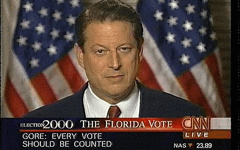
(Courtesy of CNN)
[ARCHIVE SOUND: “Boy, that was one hell of an election night. Mr. Gore will tell the country in person tonight that the election is over. Governor Bush will speak shortly afterwards as the soon to be 43rd president-elect”]
BRINKLEY: Well, it’s a watershed moment. Al Gore, as vice president had a very strong environmental record. In fact, I had written an article about him; he had given me all the letters he had – writing his wife when he used to go backpacking and camping. Somebody who had a natural feel for Nature, and you could not have had a more polar opposite people. Gore would have been putting the climate issue front and center. Bush believes totally in a deregulated, corporate environment.
VOICEOVER: May 16, 2001: Vice President Cheney releases his energy task force report advocating greater domestic fossil fuel production.
LANGSTON: From the very beginning of 2000, the administration was making a concerted effort to take apart three decades of strong environmental regulation.
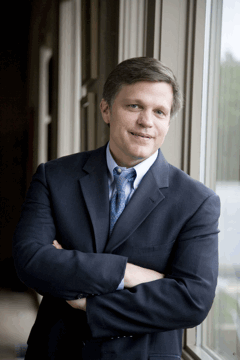
Doug Brinkley, professor of history at Rice University.
BRINKLEY: Well, Dick Cheney, his view is if it moves shoot it, if it bubbles pull it up, and if it’s buried dig it up. The idea was extract as much as you can while you can. It’s a boom time. We’ve got a president that’s going to turn a blind eye, and in fact is encouraging a kind of unregulated free enterprise. So go for it – get it.
VOICEOVER: September 11, 2001:
[NEWS REPORTER: “…effort up there yet, now remember – Oh my god!” “My God.” “That looks like a second plane. So this looks like it is some sort of concerted effort to attack the World Trade Center that is underway.”]
BRINKLEY: There’s so many different ways to look at it, but one is this fear that we now live in, almost America’s kingdom of fear – of radiation or anthrax, and all those horrible words started seeming like a reality. So, 9/11 was the feeling that, boy, we are not getting off to a good foot.
LANGSTON: Enormous concerns about terrorism and national security. And for a while I think those concerns distracted attention from the deregulation that was underway, but they also allowed the environmental movement to begin to borrow the language of security: food security, energy security. And these new languages became critical in the ability of the environmental movement to mobilize much larger constituencies.
VOICEOVER: October 8, 2004: Kenyan forestry activist, Wangari Matthai wins the Nobel Peace Prize.
LANGSTON: I think most people in America said, “Wangari who? What are we talking about? The Green Movement in Africa?” So, I think it was incredibly valuable, not just because it brought attention to a really important reforestation movement and a movement in Africa to empower women, but it also brought attention to the fact that environmental movements are not just about protecting remote places.
VOICEOVER: Aug 29, 2005.
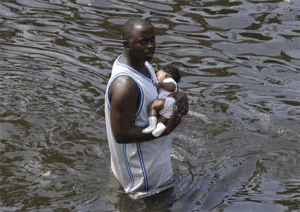
New Orleans. (Photo: Photographer's Mate Airman Jeremy L. Grisham, U.S. Navy)
[NEWS REPORTER: “Katrina blasted into New Orleans. The most powerful hurricane the crescent city has seen in modern history.”]
BRINKLEY: I was there in New Orleans for Hurricane Katrina and remember being on top of the building and watching the Mississippi River roar backwards in the opposite direction – the sheer power of that storm, it was almost hard to fathom.
[MAN: “And they don’t have a clue what’s going on down here, thousands of people that were stuck in attics, man, old ladies. And water up to their frickin’ neck!”]
BRINKLEY: You then had, of course, the man-made disaster on top of it. Katrina’s the low ebb of the Army Corps of Engineer’s history. The fact that the Army Corps didn’t properly build the levees and didn’t maintain it properly is one of the most horrendous engineering mistakes in American history.
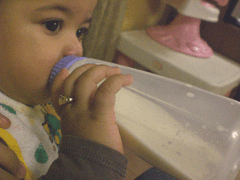
Canada’s decision spurred some retailers to pull baby bottles containing BPA from some store shelves. (Photo: joker4u2nv09)
VOICEOVER: June 2006. Canadian regulators warn the common plastic ingredient, Bisphenol A is “inherently toxic.”
LANGSTON: By 2008, that Canadian concern translated into efforts by Wal-Mart, by Kmart, by other large producers to get Bisphenol A out of the water bottle supply, out of the baby bottle supply. But what I think it’s important not to miss is that Bisphenol A was synthesized as an estrogen in the 1930s, it was intended as a commercial estrogen.
For seven decades, the industry knew that this chemical acted as an estrogen, the industry knew that this chemical was a powerful carcinogen, but for seven decades with this chemical and many others the industry suppressed the empirical evidence that should have been reported to the government.
VOICEOVER: January 2008. For the first time the price of a barrel of oil tops 100 dollars. May 14, 2008. The polar bear is added to the endangered species list.
LANGSTON: Fish and Wildlife Service scientists within the agency have been trying to declare the polar bear an endangered species for years, but year after year those efforts were blocked. Oil companies feared listing would restrict access to new oil fields discovered in Alaska, 30 million acres that just happened to be prime bear habitat. The bear has become the victim of energy greed and also the victim of secrecy, not just the victim of global warming.
VOICEOVER: September 3, 2008. Alaska governor Sarah Palin accepts the Republican Party vice presidential nomination.
BRINKLEY: What was the most memorable slogan that came out of the past presidential election? It would have been Sarah Palin with “drill, baby, drill.”
[“We will drill here and drill now, and now’s when you chant ‘drill, baby, drill’! Yes!” SOUNDS OF CHEERING “Drill, baby, drill!”]
BRINKLEY: What is “drill, baby, drill?” It’s about drilling the Arctic refuge. 50 years it’s been preserved, yet a slogan like “drill, baby, drill” catches fire. People say, yeah, let’s be energy sustainable, we don’t need Middle East oil, so let’s go destroy our great Alaskan wildlife refuge. And you don’t even hear people talking about the other side. It’s just “drill, baby, drill” versus not drilling.
VOICEOVER: Jan 20, 2009. Inauguration day.
[“Preserve, protect and defend the Constitution of the United States.” “So help you God?” “So help me, God.” “Congratulations, Mr. President.” SOUNDS OF CHEERING]
BRINKLEY: Ostensibly, it was met by a big cheer by environmental groups, but it’s kind of been in a standstill position. There’s a general feeling that more can be done, that people are looking for Roosevelt-ian boldness in conservation right now, not a kind of let’s weigh the options approach. You know, to be a c or Theodore Roosevelt you have to love the land so much that you want to save it. And I think president Obama loves people. His environmental concerns are, are people being hurt, their health due to bad environment – and I think he’s very strong on things like that. But the notion of going in and doing a radical take on, the way T.R. took on the big trusts of his era. You know, there’s not a single area Theodore Roosevelt saved – 234 million acres of wild America – nobody’s today is wishing he hadn’t saved it. We’re all saying thank you. Well, it’s going be the same 100 years from now. President Obama would come in and declare the Arctic refuge a national monument – history will shine a bright smile on that act.
VOICEOVER: February 13, 2009. Congress passes the Economic Stimulus Act.
LANGSTON: One of the most powerful things that the financial meltdown taught us was that deregulation is not always a good thing. And there are times such as the 1920s and the 1950s and the 1980s and again in the first half of this decade, where the forces of deregulation really prosper. And where we see the government is really hamstrung in its efforts to protect human health, broader public health, broader public goods.
BRINKLEY: The crisis became to save banking and save Wall Street, and to save an auto industry, which could be a good thing if Ford Motor gets back on its feet, and if General Motor now is federal government ownership, there is potential for moving into – whether it’s hydrogen fuel cells or hybrids – the federal government now might be able to start weaning us off of gasoline. I mean the 20th century it was said by Jack London, it stank of gasoline. Can the 21st century not stink of it?
YOUNG: Douglas Brinkley and Nancy Langston with a look back – and we’ve put together an environmental timeline of the decade – it’s at our website LOE dot org. So, Professors – now that we’ve heard about the past ten years, like to take a crack at naming the decade?
BRINKLEY: It’s the carbon footprint decade. If global warming continues and we don’t address it history will wonder, what were these people thinking? They were given every alarm bell. It’s like fire bells going off in a theater and everybody kept sitting and watching the movie.
LANGSTON: Was this a really hellish decade? It was not as economically hellish as the 1930s, it wasn’t as militarily nightmarish as the 1940s, but environmentally I think we have done a pretty good job of creating a nightmare decade. I think we still have a chance to reverse some of the worst impacts of global warming, help nations that are going to be most threatened by global warming to adapt. But I think we stand a big chance of losing our opportunity to reverse the environmental decade of hell.
YOUNG: Nancy Langston, from the University of Wisconsin, and Rice University’s Douglas Brinkley, thank you both.
BRINKLEY: Thank you, I enjoyed it.
LANGSTON: Thanks so much, Jeff, it was a great pleasure.
[MUSIC]
YOUNG: From financial meltdowns to melting ice caps this was the decade the bills started to come due on our unsustainable habits. Will we change in the next decade? More on that with Jared Diamond just ahead. Keep listening to Living on Earth!
Related links:
- For more on Nancy Langston’s work, click here
- For more on Douglas Brinkley’s work, click here
The Future of the Ecological Landscape
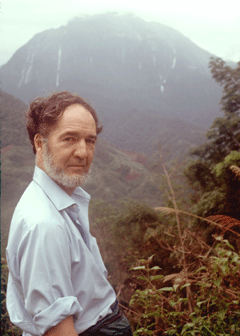
Pulitzer Prize-winning author Dr. Jared Diamond (Photo: University of California at Los Angeles)
YOUNG: It’s Living on Earth, I’m Jeff Young. We’re looking ahead to the coming decade, the environmental trends and challenges that will shape our trip to 2020. By that year, the planet will probably add about another billion people – up from our current six point eight to about seven point seven billion. Pulitzer Prize winner and UCLA Geography Professor Jared Diamond has been thinking about how all those people will eat, live, work and move around – and the resources we will consume. His book “Collapse” looked at what happened to past societies when they exceeded resources. (Spoiler alert: things did not end well for them.) Professor Diamond, welcome to Living on Earth!
DIAMOND: Thank you, and it’s good to be with you.
YOUNG: Is that our big challenge: population growth?
DIAMOND: It’s not our biggest challenge; it’s an indirect challenge. What counts is not the number of people, but it’s how much those people consume. If we add a billion people and everybody decreases their consumption rates on the average by 30 percent, then we end up in a world that’s less stressed than the world today. Whereas if we add a billion people and everybody around the world ratchets up their consumption rates, then we’re in even a bigger pickle than we are now.
YOUNG: Hmm, well, I don’t know if you visited a shopping mall in the weeks before Christmas, but somehow it doesn’t seem to me that reducing our consumption is terribly likely.
DIAMOND: I would say that in the long run, reducing our consumption rates not only is likely, but it’s a dead certainty. The reason is that our present consumption rates just can’t be sustained; we’re already running out of the world’s fisheries, we’re running out of the world’s not-yet-exploited fresh water. And so for sure a few decades from now our consumption rates are going to be lower. The only question is whether they’ll become lower in nice ways that we designed ourselves, or whether they’ll become lower in nasty ways that have been forced on us by running out of resources and by wars.

Pulitzer Prize-winning author Dr. Jared Diamond (Photo: University of California at Los Angeles)
YOUNG: Let’s talk for a moment about China because it is such a rapidly growing economy. What would our world look like in 2020 if China were to reach or approach the level of consumption that the United States has?
DIAMOND: It turns out that just China catching up to the U.S. in per person consumption rates means that world consumption of oil will double, and world consumption of metals will approximately double. That’s China alone. Then let’s think of some other countries: there’s India with a population nearly as large as China, and then there are all those countries of Africa, and South America, and Latin America, under-developed countries of Asia.
If everybody else, not just China and India catches up to American per person consumption rates, then consumption around the world increases by a factor of 11. That means we’re consuming oil 11 times faster that we are now. Well, at present we are consuming oil at a rate such that it’s guessed that in 30 or 40 years we’ll have exhausted readily accessible, cheap environmentally clean oil. If we’ve increased our consumption rates by a factor of 11, then it’s going to take us not 44 years to do that, it’s going to take us 44 divided by 11 – that’s to say 4 years, if everybody else catches up to us in consumption rates.
YOUNG: You have spent so much time looking closely at past societies that, you know, didn’t make the cut in history; made the bad choices. Is there one from history that you think we today most closely resemble?
DIAMOND: Ask me that question ten years from now because I’ll tell you whether we closely resemble these spectacular failures like Easter Island, and the classic lowland Maya, and Great Zimbabwe, and Axon, or whether we resemble the success stories.
There are success stories from the past. Japan has been going strong for something like 14,000 years without any collapse except for their military defeat at the end of the Second World War. Ticopilla Island in the southwest Pacific Ocean – Ticopilla Island has been operating sustainably for 3,200 years.
My friends in the New Guinea Islands have been operating for 46,000 years and there’s no sign of collapse in the New Guinea Islands. So, the United States, if we make the good decisions, we’ll resemble Japan, and Ticopilla, and New Guinea Islands, and if we make the bad decisions, we’re going to resemble either Easter Island that underwent a collapse and a civil war, or we’re going to resemble Norse Greenland where everybody ended up dead around the year 1440.
YOUNG: And summing up, are you an optimist or a pessimist looking ahead to 2020?
DIAMOND: Summing up, I’m not an optimist; I’m not a pessimist. I would describe myself as a cautious optimist, and by that I mean that the problems that we face are all problems that we are causing, and so if we decide to solve the problems, we can solve them.
I’m not worried about some asteroid that we can’t stop crashing into the Earth – that would be a hopeless problem, an unsolvable problem. Instead, I’m concerned about what we people, ourselves, do with our water, and our forests, and our fish and our topsoil. We already know how to manage forests, and fish, and waters sustainably and we do it in some cases. All we have to do is do it in the other cases, as well, and we’ll be sailing off into a happy future; my children will end up in a world worth living in.
YOUNG: Author and geographer, Jared Diamond, thank you very much for your time.
DIAMOND: You are welcome.
YOUNG: Organic Farmer Fred Kirschenmann says if we don’t want to follow the footsteps of the Maya or Easter Islanders we will probably have to change our agriculture. Kirschenmann’s President of Stone Barns Center for Food and Agriculture in New York, and a fellow at Iowa State University’s Leopold Center for Sustainable Agriculture. Here’s how he sees farming 10 years from now.
KIRSCHENMANN: Our current agriculture system is based on several resources that we’ve been able to depend on now for the last 60 years when we’ve developed industrial agriculture. Those resources are cheap energy, surplus water, stable climates that we’re not going to have in the future.
So the thing that we have to imagine, I think, is what kind of food system will work when crude oil reaches say 300 dollars a barrel? And what kind of food system will be productive, and productive even with an increasing human population under these new circumstances? And I think it’s going to be a food system that is based much more in resilience than it is in just productivity, and that’s going to mean a much more diverse food system than we have now.
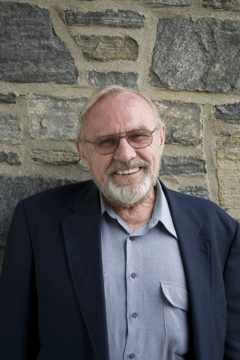
Organic farmer and agricultural thinker Fred Kirchenmann.
YOUNG: Organics expert, Fred Kirschenmann. Pro-basketball star turned urban-farming pioneer Will Allen thinks he has a sustainable agriculture solution for the coming decade: bring the farms closer to the forks. Allen won a Macarthur Genius grant for the ideas behind his Milwaukee farm, Growing Power.
ALLEN: Growing Power is a not-for-profit organization and we’re producing enough food to feed about 10,000 people with our ten farms. I do this work because my personal goal is to be a part of ending world hunger. And I don’t think we can end world hunger with our industrial model that hasn’t been working, so I think it needs to be a combination of things.
I see food being grown all over the place, whether it’s in vacant buildings, rooftops, on top of asphalt concrete. And just think about it, if we can go from, like most cities, less than one percent of local food production to say five to 10 percent that’s going to improve our environment. That’s five or 10 percent less trucks traveling into our cities, the money will stay in local communities and circulate, and that’s very important. We can create thousands of jobs.
So, it’s a new kind of farming, not looking at acreage, but looking at square footage. So, we’re going to build the nation’s first vertical farm, a five-acre glass building in the next year, year and a half. If you could imagine if you would take five greenhouses and stack them on top of each other, so it’s using vertical space. Because inside some cities, like New York and San Francisco where there’s not a lot of vacant land we’re going to have to go up in the air. You can imagine inside a vertical farm, lets say there’s 8,000 square-feet of space and then inside each one of those stories you’re able to grow vertically and increase the square footage to say, 12,000 square-feet by using that vertical space by hanging baskets and so forth. Well, we’re going to do a little tour here of the farm.
[SOUNDS OF SQUEAKING DOOR AND FOOTSTEPS]
ALLEN: In this greenhouse, we have plants that are not on the same plain, but we have hanging baskets above the benches, so we’re able to increase the square footage from about 3,000 square-feet to about 5,000 square-feet.
[SOUNDS OF RUNNING WATER]
ALLEN: Down the center greenhouse, a 10,000-gallon system that’ll grow 10,000 lake perch – this is called aquaponics. Above that are two beds with watercress and the water is being pumped up, gravity brings it to the other end; it’s a closed system and it’s the symbiotic relationship with the fish that give off ammonia and the plants take out nitrate in the water, and therefore the fish survive because the water is being cleansed. And the water quality is very important, especially when you talk about raising lake perch that are mercury-contaminated in the great lakes and we can’t commercially fish for them in Lake Michigan anymore.
I’m actually going to pull up some lake perch.
[SOUNDS OF SPLASHING WATER AND FLAPPING FISH]
ALLEN: I just pulled up about ten lake perch – they’re delicious.
[FLAPPING SOUNDS CONTINUE]
ALLEN: You can probably hear the fish flopping around here. Let’s put these back in.
We’re going to move on to greenhouse number eight. And this greenhouse is an example of how we use compost. To heat this greenhouse, with a 150-degree temperature coming out of these piles, that’s what helps keep the plants viable throughout the winter. As I walk by, you can see the steam coming as I dig down into this bin.
I think you’re looking at 2020 when you come to Growing Power because this is the way I think food will be raised: very intensively. Going back to a very hands-on way of growing food. It will be not your traditional farmers operating these farms, there’ll be folks that come from urban areas and didn’t grow up on farms. We need about 50 million more people producing food to fundamentally change the system. We know how to do it, now we have to scale it up; we have to involve everybody in a very multi-cultural, multi-generational way.
It’s to everybody’s benefit that we start eating healthy- we know that if we don’t, diabetes is going to increase by 50 percent over the next 25 years. Food should not be making us sick. I don’t think it’s a movement anymore, I think it’s a revolution, that’s why I call it the Good Food Revolution. And that’s what the future looks like I think.
YOUNG: Growing Power CEO Will Allen. You can learn more about his urban farm, that and much more, at our website, LOE dot org.
[MUSIC]
YOUNG: Climate change and biodiversity loss will not only remain major challenges in the next ten years, in all likelihood they will accelerate. The International Union for the Conservation of Nature says some 17,000 species are in danger of extinction. And shifting precipitation patterns and rising sea levels will further stress many ecosystems as the planet warms. University of Texas biologist Camille Parmesan says that will bring some tough choices for conservationists.
PARMESAN: A lot of people ask me, well won’t species just adapt, won’t they just evolve? And to some extent, yes, in populations we’re seeing changes in gene frequencies that make that population better adapted to say hotter conditions – we call that micro-evolution. But those are very, very minor genetic changes. What we’re not seeing is what we call macroevolution; we’re not seeing any new genes emerge. So, new mutations that would allow that species to survive in a climate space that that species has never lived in before. And when we’ve had past major climate shifts we do see a lot of species extinctions. And what we’re shifting into is a warmer regime that we haven’t had for some three million years. What we’ve seen are that something like 52 percent of all species are showing responses to climate change, which is a huge proportion.
So we’re having to start thinking out of the box. And a group of us have been promoting a concept called assisted colonization or assisted migration or assisted translocation – many names. The idea is that we’ve always moved species around in conservation, but what we’ve done is we’ve moved them back into areas where they used to occur. But, with climate change, perhaps we need to be thinking not of moving them where they used to be, but to where they should be in the next hundred years, as climate shifts.

Biologist Camille Parmesan. (Courtesy of the University of Texas-Austin)
Now, this is very controversial because it means moving species out of their historic range, and a lot of conservation biologists are extremely worried that we’re going to start invasive species. [Laughs] Which is one of the reasons why species have become endangered in the first place. We certainly don’t want to do that, we need to do it carefully, but my counter argument is that if we do nothing we’re going to see an awful lot of what we care about and what we’ve worked all these decades for just go extinct.
I mean some of them I don’t think we have any hope of saving. I really don’t think the polar bear can survive the next century or two, but other species like if we have mountaintop species that are in southern California, we could imagine moving them a few hundred miles north to northern California, and perhaps allowing them to persist when otherwise they would go extinct.
There are a lot of species that we can already imagine would be good candidates for this kind of assisted colonization. Species that are fairly innocuous, they’re not very competitive and we know we can easily translocate them. And some of those species are butterflies, which happen to be my study organism. So, we’re seeing – already seeing many butterflies declining, the mountaintop species definitely. But even some temperate, lowland species because what is happening to many of them is they can’t just shift north because you’ve got Los Angeles and San Diego in the way. And so it’s really our duty to assist them.
Well, you don’t want to do this for a big predator. I would not think of moving tigers around, I would not think of moving polar bears to Antarctica – nothing of that extreme. We’d be talking about moving species just a few hundred miles, or a few hundred meters up, to the next mountain range, to somewhere just a little bit further north. So, fairly small shifts to the next good habitat patch.
So, rather than thinking, here’s my little patch of land, I’m going to put a fence up around it, and I’m going to make sure nothing gets in – what we need to think of is how to preserve biodiversity globally. So, maybe your little preserve will lose a lot of what that preserve was set up for, but then new things will come in as species are shifting around the globe.
People do claim that we’re acting as gods when we start doing this, and my response is that is such hubris because humans are fiddling with Nature all the time. I mean, if you’re going to say that one different kind of fiddling is suddenly a god-like act when none of the other things we’ve done – we’ve caused the extinction of just hundreds to thousands of species without even blinking an eye. And to say that the act of trying to save one is suddenly god-like is just hubris. The geo-engineering schemes I think are even more radical than the biological engineering schemes because I think we know a lot more as biologists about the systems we’re studying. Whereas, the geo-engineering schemes really, once we start doing those it’s one shot, it’s one experiment. [Laughs] I mean, I would be horrified at imagining taking action on a theory that we’ve actually got no experimental back up that that theory is going to work.
Even if we have mass species extinctions in another few million years new species will evolve. Life will continue. But humans, as a species, are really very vulnerable and I don’t think humans realize just how vulnerable they are. We haven’t really been around all that long. I mean much of our history is in an earth that’s as it is now or colder. And if you look at our culture, art, writing, agriculture. A lot of these things didn’t emerge until about 10,000 years ago when the climate stabilized. It’s very difficult to have agricultural areas, urban areas, societies when you have a very variable climate, a very shifting climate. And so what we’re talking about is really fundamentally different from the kind of conservation issues that we faced in the past.
YOUNG: University of Texas biology professor Camille Parmesan.
Related links:
- To learn more about the Stone Barns Center for Agriculture, click here.
- Click here for more on the Leopold Center for Sustainable Agriculture.
- To learn more about Fred Kirchenmann and his 3,500-acre certified organic family farm in North Dakota, click here.
- Jared Diamond’s page at UCLA’s Department of Geography.
- Learn more on Camille Parmesan and assisted migration here.
- To Hear a Longer Interview with Camille Parmesan Click here
- To Hear a Longer Interview with Jared Diamond Click Here
- To Hear a Longer Interview with Fred Kirchenmann Click Here
- LOE Series on World Trade Center Pollution
- LOE Coverage of Wangari Maathai
- LOE Coverage of Hurricane Katrina
- LOE Coverage of the Obama-McCain campaigns
- Gore Hits the Global Warming Campaign Trail
The Future of the Human Landscape
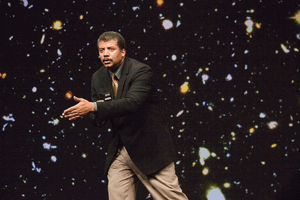
Neil DeGrasse Tyson warns that the Apophis asteroid is heading towards us. (Photo by Greyhawk68)
[CHILDREN SINGING]
YOUNG: It’s not just biological diversity that’s at risk – we’re also losing diversity of human expression – this could be one of the last times we hear sounds like this: the Chamacoco language of Paraguay.
HARRISON: We are losing languages at a very rapid pace, some people have estimated as frequently as a language every two weeks or so. This trend is going to continue into the next decade.
YOUNG: Tapping high tech to save indigenous languages. That’s just ahead on Living on Earth – stay tuned.
YOUNG: It’s Living on Earth, I’m Jeff Young and we’re looking ahead to the coming decade. Hundreds of native languages are expected to die by 2020 – unless David Harrison of the Living Tongues Institute has his way.
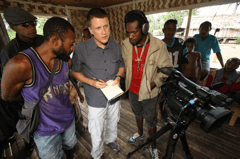
Dr. David Harrison works with John Agid (left) of Matugar village, Papua New Guinea, to record the endangered Panau language. (Photo: Chris Rainier)
HARRISON: I feel a great sense of responsibility when I am sitting at the foot of an elder. I want to hear every single word that they are prepared to share with me. And I want to listen very attentively to record it, to understand it, and often even the people in their own household or their neighbors don’t recognize or even known that they happen to know this ancestral language.
So, what you get is a few elderly speakers scattered across different locations. I’m able to create new situations for them. I actually transport elders from one village to the other, and they just love it. They just start talking – they even forget that I’m there, that I’ve got a camera and a recording device. For example, our last speakers of Chulym in Siberia. And the Chulym language is highly likely to go extinct within the coming decade. I can play a little sound clip for you of some conversation in Chulym among some of the very last elders:
[ELDERS SPEAKING CHULYM]
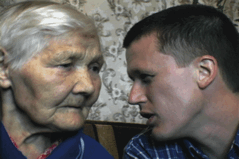
Chulym-speaker Nina Tarlagonova and Dr. David Harrison in a still shot from The Linguists. (Courtesy of Ironbound Films, Inc.)
HARRISON: One of the projects that I’ve been working on with the Living Tongues Institute is to help some of these small languages cross the digital divide and to bring them over into high tech domains, so that the members of the community can say, oh well of course my language is suitable for text messaging or can be posted on social networking site; it’s just as good as any other language. I can use it in all these domains.
And I’ve created a suite of talking dictionaries for some small and not very well-represented languages. I’m right now in the process of turning the talking dictionary into an iPhone application. So, you would actually be able to have your iPhone and to download and play and listen to sound files from very small languages that are maybe endangered or may not be very well represented in cyberspace yet, but they will be. And this is really the key. And these languages, once they have that opportunity, once the door is open to them to enter into high tech domains, of course they will adapt. They will develop all of the little shortcuts that we have in English, the sort of “LOL” text messaging abbreviations and things. They will adapt perfectly because adapting to new circumstances is really what languages do best. It’s not an inevitability. Small languages do not have to be extinct. They don’t have to be oppressed out of existence. There’s room in the world, there’s room in the human intellect for a diversity of languages.
YOUNG: Living Tongues Institute Director David Harrison. Technology will continue to shape our tongue in the coming decade, too, bringing radical change to that ultimate arbiter of the English language – the dictionary. Lexicographer Erin McKean once edited the New Oxford American Dictionary. Now, she’s working to close the book on dictionaries, as we know them.
MCKEAN: Oh totally, but I think that the book shape is the wrong shape for the dictionary. I don’t know if you cook very much, if you’re from the South you may have actually cooked with Crisco. But at some point in the recent past you started being able to get Crisco in sticks. I think that Crisco in a stick is one of the triumphs of modern civilization. Because it’s so much easier to cook with. The tub is the wrong shape for Crisco because you get it all over your hands; it’s really hard to measure.
YOUNG: That’s true.
MCKEAN: In the same way the book is the wrong shape for the dictionary because it’s too small, it can’t hold all the words. It can’t even hold all the right kinds of information about the words that it does hold. It doesn’t tell you anything about people’s opinions about a word. It doesn’t tell you people think this word is beautiful. It doesn’t tell you, oh, this adjective is only used with these objects. It doesn’t tell you words work, it only tells you what words mean, and what words mean is just one facet of how words work.
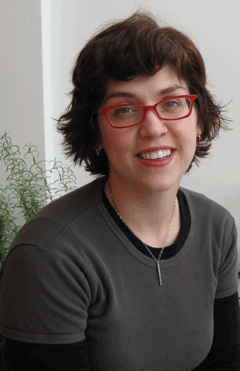
Lexicographer Erin Mckean.
YOUNG: So, the way we use a dictionary is clearly going to change. Is the content of the dictionary going to change a lot, as well? What’s going to get in?
MCKEAN: Every single word, or phrase, or idiom, or combination. The only reason that some things are in a dictionary right now and some things aren’t is that the print book is just too small to hold every word of English. Even the Oxford English Dictionary has fewer than a million words in it, and it’s pretty easy without even doing a whole lot of heavy lifting to find more than, say, four million unique English words.
YOUNG: You got to draw the line somewhere. If I just say “squizzlebop” is that going to be a word?
MCKEAN: If you use it as a word, it’s a word. It’s all about intent and communicative value.
YOUNG: This is anarchy! This is anarchy!
MCKEAN: [Laughs] No, it’s not! Just because a word is a word, doesn’t mean it’s a good word. And so part of the job of the dictionary is to let you know, most people think this word is terrible, so maybe you don’t want to use it. A lot of people feel that if a word’s in the dictionary it’s perfectly okay to use, and if it’s not in the dictionary it’s perfectly not okay to use it. And this is not a very good system for making word decisions because the dictionary is on a time lag, especially print dictionaries, and because there may be words that are perfectly, let’s say cromulent in certain contexts that are not okay in other contexts.
YOUNG: Cromulent? Excuse me; I have to go to a dictionary.
MCKEAN: [Laughs] That’s a word you may not find in the dictionary because it’s from an episode of “The Simpsons”. And cromulent means “okay” and it was actually used when one of the teachers in Bart’s school was saying to another teacher, you know, I can’t believe you don’t know that word – it’s a perfectly cromulent word.
[YOUNG laughs]
MCKEAN: But once it was used in “The Simpsons” it became a word, automatically.
YOUNG: Uh huh. Well, will emoticons ever make it into the dictionary? Please say no.
MCKEAN: [Laughs] I’m going to have to disappoint you.
[YOUNG groans]
MCKEAN: Well, okay, but think about this: the exclamation point, if you really think about it, is a kind of emoticon.
YOUNG: Hmm.
MCKEAN: It’s an image that tells you what kind of expression goes with the sentence. I mean think of the difference between saying, “It’s on fire” period, and “It’s on fire” exclamation point.
YOUNG: Is there any place at which I can make you draw the line and say, “No, sorry that’s just not acceptable – that’s not a word.”
MCKEAN: People have tried. [Laughs] But the truth is that I’m not the person who decides what’s a word and what’s not a word. If you use something as a word, there’s a little magic an alchemy that happens that makes that a word.
YOUNG: But you’re writing dictionaries! Isn’t that your job?
MCKEAN: My job is to map the language. So, I tell you where everything is, and what it is. But I don’t leave the red-light district off the map because I disapprove of it.
YOUNG: Mm hmm.
MCKEAN: That would make a pretty bad map. And then you’d stumble into the red-light district and not know where the heck you were. And that wouldn’t help anybody.
YOUNG: Are we headed toward something better than a word?
MCKEAN: In my opinion there is nothing better than words. Even if they invented some magical telepathy device or something that let us convey emotion through perfume or anything else. Nothing is better than words. And that is possibly my not inconsiderable bias talking.
YOUNG: Erin McKean, lexicographer and now CEO of a new online dictionary, called Wordnik. Thanks very much.
MCKEAN: You’re very welcome.
[MUSIC: Laurie Anderson’s “Language is a Virus”]
YOUNG: And now, from living languages of the coming decade to living buildings.

Rachel Armstrong is a Senior TED Fellow who advises architects on the protocell system. (Photo provided by Rachel Armstrong)
ARMSTRONG: I’m Rachel Armstrong. I advise architects on how to incorporate biological systems into their design work. My work at the moment involves a system called the protocell.
Protocells are self-assembling, autonomous, very primitive chemical systems that have some of the properties of living systems, but are not strictly speaking alive. They are capable of life-like processes such as growth, movement, sensitivity and I think these protocells are going to be incredibly important for us in the next ten years or so, in that we will develop materials that we can put on the outside of buildings that can take carbon dioxide from a carbon-rich air that we produce in the cities and around our homes and factories, and then we’ll trap the carbon dioxide and fix it as a solid material on the outside of the buildings and we will see our buildings transformed by these materials that are carbon fixing. This is going to give quite interesting appearance to a community of houses, so down your street now.
[MUSIC: The Books “Future, Wouldn’t That Be Nice]
ARMSTRONG: All the buildings have got this biolime, let’s call it, on the outside of the buildings. It’s gradually growing and you can see little stalactites and stalagmites – little spicules of limestone that has managed to stray away from the outside of your home. And maybe there’s a source of carbon emissions, maybe somebody’s got a dirty chimney down the road and the biolime will actually start making its way toward that source of nutrients because it would regard carbon emissions as being something that it would like to engage with and turn it into a crystal. And so, you could start to imagine two buildings would snuggle up together and they will lose the space between them. It’ll be a bit like cloud watching, where we will start to see different characters in different houses. So, maybe some houses will look like a giant goblin, others would look more like a sleeping cat.
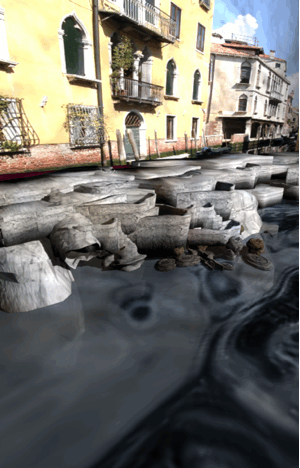
An a artificial limestone reef growing under Venice just might save the historic city. (Photo: Christian Kerrigan)
[MUSIC CONTINUES]
ARMSTRONG: So, these technologies will be quite visible and there’s a real reason for this, and I think this is an important reason that at the moment it’s very hard to get any kind of handle on how we are affecting our environment by the production of carbon emissions; we can’t see carbon dioxide. But when we actually are able to see it in a material way, growing on the outside of our houses, we can actually start to have a personal relationship with carbon dioxide levels. We can see that maybe one-year the growth of the houses is much thicker than another year, a bit like the rings in the bark of a tree. The protocells will become more autonomous as we develop the science that’s underpinning them. It’s predicted that in the next ten years, that protocells may actually be able to self-regulate and divide.
[MUSIC CONTINUES]
ARMSTRONG: The way I think that these completely challenge our understanding of technology is that at the moment we consider technologies to be things that we can control at the push of a button. I think the 21st century is going to give rise to technologies that we don’t control by subordination, by annihilation through antibiotics and antiseptics. What we need to do in order to get the best out of these technologies is to become engaged with them. So that we interact with them, we monitor them, and we live with them; we live along side them, just like all the other species on the planet. We blossom when we’re in complex ecologies and I think that synthetic ecologies and synthetic organisms are going to be an important part of that integrated balance that we should attain if we are able to behave in a more responsible and grown up manner towards all living forms on the planet.
YOUNG: Architectural advisor, Rachel Armstrong.
[MUSIC: The Books “There Is No There]
YOUNG: Well, we’ve heard a lot about problems we’ll face on our planet in the coming decade – many of them of our own making. But astronomer Neil DeGrasse Tyson says we’ll also need to keep an eye on the sky. Tyson directs the Hayden Planetarium at the American Museum of Natural History in New York, where, among other things, he keeps watch on an asteroid called Apophis.
TYSON: You know the solar system’s a shooting gallery. And Earth, many people don’t know, plows through several hundred tons of meteors a day. So, the range of these that could hit us is huge.
[SOUNDS OF SCI-FI SPACE]
The 1998 film Deep Impact dramatizes what an Apophis tsunami might look like.
TYSON: Apophis – that was discovered in December 2004. It’s an asteroid about the size of the Rose Bowl. If the Rose Bowl – imagine that as kind of like an eggcup, and you place something in it to hold it, that’s about how big that asteroid is. That’s not too shabby – that one, if it hits, it’ll do some serious damage.
[SCI-FI SOUNDS: “And it’s going to strike the Earth in six days.”]
TYSON: The first calculation showed that there was a real chance it could hit Earth in the year 2029 on April 13th. Which, by the way, happens to be a Friday. No one read about this because coincidentally over that same week we had the tsunami in Indonesia and so that rightly got the headlines given the death toll that that exacted. What’s intriguing, however, is that if this thing hits Earth, the current trajectories show it would hit the Pacific, if it hits the Earth at all, and that would create a tsunami on the West coast that would dwarf anything that happened in Indonesia.

Neil DeGrasse Tyson warns that the Apophis asteroid is heading towards us. (Photo by Greyhawk68)
After better orbit was calculated because once you discover something you have a few data points and there’s huge uncertainties if you only have a few observations. As the months went by we had better orbital data and we determined that no, it will not hit us April 13th 2029, but it will come very close. It will come closer than Earth’s orbiting communication satellites. It’ll be the biggest, closest thing we’ve ever seen in the history of history. It’d be visible from northern Europe and it’s basically – think of it as a shot across our bow. The universe saying, “I’ll miss you this time, but I’ll give you another chance to try to deflect me.”
Depending on its actual trajectory on that pass we will learn whether it will hit us April 13th, 2036 – we’re on a seven-year intersection orbit.
Our orbit, plus the orbit of that one, intersects every seven years. Currently, the best estimate is several in a million that it will hit us. And you say, “Ahhh, let’s not worry.” Well, if it hits us it could do a trillion dollars worth of damage, and so several in a million you get some insurance people they can calculate how much – what kind of insurance you want to take out given what kind of risk that represents. And it means you should be doing something.
[SCI-FI RECORDING: “But how can the entire world prepare for the ultimate disaster?”]
TYSON: Oh, so you want to protect the Earth and you realize, in fact, that everybody has to agree to do this, and…yes, that’s a whole other level of international cooperation. So, if an asteroid’s going to come and render Earth extinct, then petty differences among people chosen for completely arbitrary reasons of what god you worship, or what skin color you are, or what line in the sand separates your property that all that pales compared to the prospect of going extinct.
So, yes, we would need international cooperation. What many people, we have top sort of engineers and dynamicists working on – one problem, which is – involves what we call a gravitational tractor. A kind of a tractor beam where you send up a spaceship, bring it close to the asteroid, but not touch it, and you sort of park it there. And what I mean by – both of these are moving through space so when I say park, I mean you match velocities with the asteroid. And their mutual gravity will want to attract them to each other. And as they drift, you say, no, I’m not going to let that happen. So, you put on the little retro rockets on the rocket to prevent them from colliding. The act of doing that effectively tugs the asteroid out of harm’s way. Because all you really want to do is move it so that it will not hit Earth in its trajectory. It’ll still be out there, its orbit will still cross the orbit of the Earth, but you’ve lived to enjoy another day.
[MUSIC]
TYSON: That’s really the way to do it. So, it’s a matter of how much do you want to protect the Earth, really what it comes down to.
YOUNG: Astronomer Neil DeGrasse Tyson directs the Hayden Planetarium at the American Museum of Natural History in New York. You can hear more from him and many of the other big thinkers in today’s show – and take a trip through the past decade with an interactive timeline – it’s all at our website, LOE dot org.
Related links:
- National Geographic's Enduring Voices Project identifies the world’s language hotspots- places with the most, threatened native tongues.
- The Living Tongues Institute documents endangered languages and propels them from traditional homeland to new media.
- To hear Erin's TED talk, "Erin McKean redefines the dictionary," click here.
- Visit Wordnik, Erin Mckean's online dictionary
- The Near Earth Object Program
- To hear a longer interview with David Harrison click here
- To hear a longer interview with Erin McKean click here
- Click here to hear Neil de Grasse Tyson on alien intelligent life
- Click here to hear Neil de Grasse Tyson on the future of space exploration
- Click here to hear Rachel Armstong on space tourism
YOUNG: Living on Earth is produced by the World Media Foundation. Our crew includes Bobby Bascomb, Eileen Bolinsky, Bruce Gellerman, Ingrid Lobet, Helen Palmer, Jessica Ilyse Smith, Ike Sriskanderajah, and Mitra Taj, with help from Sarah Calkins, Marilyn Govoni, and Sammy Sousa. Today we bid a sad and very grateful farewell to our interns Quincy Campbell and Nirja Parekh. Technical help this week from Dana Chishom. Jeff Turton is our technical director. Alison Lirish Dean composed our themes. Steve Curwood is our executive producer. You can find us anytime at LOE dot org. I’m Jeff Young. Thanks for listening.
ANNOUNCER: Funding for Living On Earth comes from the National Science Foundation supporting coverage of emerging science. And Stonyfield farm, organic yogurt and smoothies. Stonyfield pays its farmers not to use artificial growth hormones on their cows. Details at Stonyfield dot com. Support also comes from you, our listeners. The Ford Foundation, The Town Creek Foundation, and The Oak Foundation supporting coverage of climate change and marine issues. And Pax World Mutual Funds, socially and environmentally sustainable investing. Pax world for tomorrow. On the web at pax world dot com.
ANNOUNCER 2: PRI – Public Radio International.
Living on Earth wants to hear from you!
Living on Earth
62 Calef Highway, Suite 212
Lee, NH 03861
Telephone: 617-287-4121
E-mail: comments@loe.org
Newsletter [Click here]
Donate to Living on Earth!
Living on Earth is an independent media program and relies entirely on contributions from listeners and institutions supporting public service. Please donate now to preserve an independent environmental voice.
NewsletterLiving on Earth offers a weekly delivery of the show's rundown to your mailbox. Sign up for our newsletter today!
 Sailors For The Sea: Be the change you want to sea.
Sailors For The Sea: Be the change you want to sea.
 The Grantham Foundation for the Protection of the Environment: Committed to protecting and improving the health of the global environment.
The Grantham Foundation for the Protection of the Environment: Committed to protecting and improving the health of the global environment.
 Contribute to Living on Earth and receive, as our gift to you, an archival print of one of Mark Seth Lender's extraordinary wildlife photographs. Follow the link to see Mark's current collection of photographs.
Contribute to Living on Earth and receive, as our gift to you, an archival print of one of Mark Seth Lender's extraordinary wildlife photographs. Follow the link to see Mark's current collection of photographs.
 Buy a signed copy of Mark Seth Lender's book Smeagull the Seagull & support Living on Earth
Buy a signed copy of Mark Seth Lender's book Smeagull the Seagull & support Living on Earth

